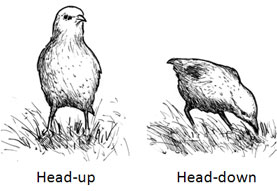|
Birds can
adopt different body postures depending on the type of
activity. When birds are on the ground and they seek
food, there can be head-up or head-down. When head-up,
they are usually scanning the environment for potential
predators or food (vigilance behavior). When head-down,
they are usually in the processes of grabbing food with
their beaks or handling food (foraging behavior).

One of the interesting things that occurs
when birds move from head-up to head-down
positions is that their blind spots at the rear of their
heads change location. Thus, a bird head-up can easily
see part of the sky above him (scanning for predators);
whereas, when head-down, the sky is no longer in sight
because of the blocking effect of the blind spot.
Obviously, this could reduce the ability of a bird to
detect a predator approaching. The extent to which this
blocking effect is meaningful depends on the size of the
blind spot. The size of this blind spot differs
enormously among different bird species, which raises
the question as to how much visual coverage different
bird species loose when they are head-down foraging. To
answer this question, we need to compare the
configuration of visual fields among different types of
species.
Previous:
Measuring visual systems Next:
Eye positioning
|